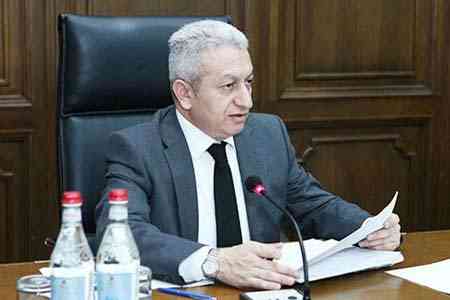


ArmInfo.The performance of the state budget of Armenia should become predictable. On February 4, the Minister of Finance Atom Dzhandzhugazyan stated this at a hearing on the implementation of the state budget of the country for the first nine months of 2019 in the commission on financial-credit and budgetary issues of the National Assembly of the Republic of Armenia.
According to him, over the past few days there have been chronic deviations from the feasibility of the country's main economic law, and in this context, increasing fiscal discipline is becoming one of the priority tasks for the government. "Improving the quality of the state budget expenditures should become the norm," the minister said, pointing out the importance from the point of view of prospects for the dynamics of tax revenues and improving the quality of expenditures of public resources. Otherwise, as the minister noted, all successes will look like a pure coincidence.
It should be noted that in Armenia, the growth of economic activity in January- September 2019 compared to the same period in 2018 accelerated from 6.5% to 7.1%. According to the Statistical Committee of the Republic of Armenia, in September 2019 alone, economic activity growth was 7.8% with an annual growth of 7.8%, against last year's September growth of 8.5% and annual growth of 0.2%. The growth of economic activity in January-September 2019 was largely determined by the services sector and the industrial sector, respectively, by 15.5% and 9.7% per annum, and to a lesser extent, trade and construction - by 8.8% and 4.4%, respectively. , and in the energy complex and the agricultural sector a decline of 2.2% and 4.8%, respectively, was recorded. A year earlier, in January-September 2018, against the same period of 2017, growth was recorded in the services sector - by 19.1%, trade - by 9.6%, construction - by 7.6%, the industrial sector - by 4%, and the energy complex - by 0.5%, and the agricultural sector showed a decline of 4.8%. The industrial production price index increased in January-September 2019 compared to the same period in 2018 by 0.5%, only in September 2019 - by 1.4%, and compared with September 2018 - by 3.1%.
A year earlier, in January-September 2018, against the same period in 2017, the industrial products price index increased by 2.3%, only in September 2018 - by 0.2%, and in September 2018 compared to September 2017 it decreased by 1.1%. On a monthly basis (in September), the decisive impetus to the growth of economic activity came from the construction sector - 4.9% (against 4.4% growth in September 2018) and the services sector - 3.6% (against 5.7% growth in September 2018). The monthly growth of the remaining areas turned out to be much more modest: the trade sector and the industrial sector - by 0.6% each (against growth by 2.1% and 0.6%, respectively, in September 2018). The energy complex in September 2019 showed minus dynamics (8.8%), as a year earlier in the same month (11%). In annual terms (September 2019 to September 2018), the highest growth was demonstrated by the sector and the industrial sector - 15.1% and 11%, followed by the energy complex - 9.3%, trade - 7.5% and the construction sector - 4.2%. A year earlier, in September 2018 compared to September 2017, growth was recorded in the services sector - 19.8%, in the retail sector - 8.8%, in the construction sector - 3.5% and in the industrial sector - 0.9%, and was recorded in the agricultural sector and energy sector decline - by 17.7% and 5.5%, respectively. According to statistical data, in January-September 2019, the trading sector with the volume of 2.3 trillion holds leadership in absolute terms. drams ($ 4.7 billion).
The second place is taken by the services sector - 1.5 trillion drams ($ 3.1 billion), the third - the industrial sector - 1.4 trillion ($ 2.9 billion), the fourth - agriculture - 574.4 billion drams ($ 1.2 billion), and the fifth - the construction sector - 251.8 billion drams ($ 523 million). The volume of electricity generation in January-September 2019 amounted to 5650.6 million kWh, of which 642.9 million kWh - only in September. At the same time, the foreign trade turnover of Armenia in January-September 2019 amounted to 2712.9 billion drams ($ 5639.6 million) with an annual growth of 5.8%. In its structure, exports underwent annual growth of 7.9% to 918.3 billion drams ($ 1909.2 million), while imports - annual growth of 4.7% to 1794.6 billion drams ($ 3730.4 million). In September 2019, by September 2018, the foreign trade turnover of Armenia increased by 30.1% due to an increase in exports by 33% with an increase in imports by 28.8%, and only in September 2019 the increase in foreign trade turnover by 13.1% was largely triggered by an increase imports by 20.5% than exports with an increase of only 0.2%. A year earlier, in January-September 2018, foreign trade turnover increased by 22.4% due to an increase in exports by 11.6% with an increase in imports by 28.6%. In September 2018 compared to September 2017, the foreign trade turnover of Armenia decreased by 3.6% due to a decline in exports by 14.8% with an increase in imports by 2.7%. In September 2018 alone, the foreign trade turnover of Armenia decreased by 10.1% due to a decline in exports by 11.6% and imports by 9.3%. The average settlement rate of the dram in September 2019 amounted to 476.23 dr / $ 1, and in January-September 2019 - 481.52 dr / $ 1, against 483.82 dr / $ 1 in September 2018 and 482.21 dr / $ 1 in January-September 2018